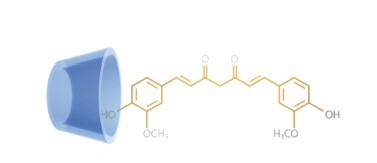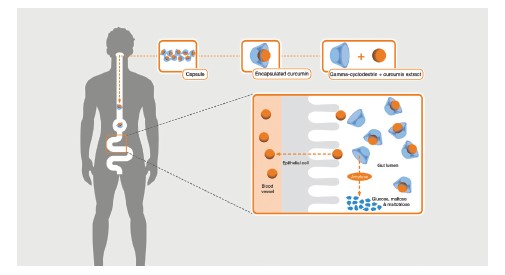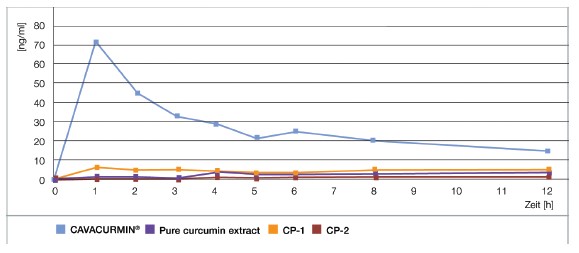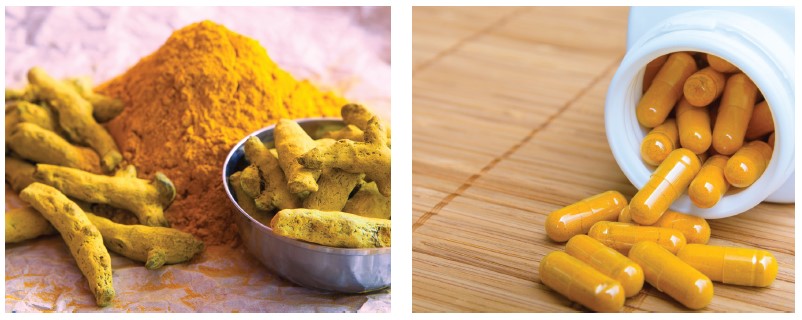Increased Bioavailability of Curcumin Through Molecular Encapsulation with Cyclodextrin
Cyclodextrins are molecules with special talents: they are capable of accommodating selected hydrophobic molecules, protect or stabilize them, and release them via an equilibrium controlled process.
This principle gives way to an innovative technology platform enabling interesting applications in the food industry – particularly to increase the bioavailability of hydrophobic health- promoting ingredients such as curcumin.
Functional foods are experiencing a strong increase in popularity, as consumers all around the globe are more frequently opting for dietary supplements or foods with additional benefits to enhance their wellbeing.
Consequently, scientists and food researchers are continuously discovering new health-promoting ingredients that are supposed to make the body resistant to environmental stress, prevent certain diseases or even slow the aging process.
However, functional foods can also be demanding when it comes to formulating them. Health-promoting ingredients such as vitamins, antioxidants, flavors and many different plant extracts are often affected by light, low pH values or high temperatures, and must therefore be stabilized. Additionally, many ingredients are not water-soluble.
It is therefore very challenging to formulate stable functional foods or dietary supplements with hydrophobic active ingredients and, at the same time, to ensure adequate bioavailability for the consumer. A possible solution offers cyclodextrin technology.
Cyclodextrin Technology
Cyclodextrins are ring-shaped sugar molecules (chiral cyclic oligosaccharides) with consistent technical properties that have been known to science and research for over 100 years.
According to the number of glucose units, a distinction is made between α-, β- and γ-cyclodextrin: α-cyclodextrin consists of six, β-cyclodextrin of seven and γ-cyclodextrin of eight glucose units. Native cyclodextrins are colorless, non-hygroscopic crystalline solids, which can withstand temperatures up to around 220°C.
The molecules are stable in an alkaline environment, but are hydrolyzed in acidic solutions (at pH < 2.5).Produced from renewable raw materials, cyclodextrins are natural starch-conversion products.
For industrial use, they are manufactured biotechnologically by enzymatic degradation from vegetable starch-containing raw materials, such as corn or potatoes. Specific enzymes cut individual sections out of the helical carbohydrate of starch and combine them in an annular oligosaccharide: the cyclodextrin.
Cyclodextrins’ special feature is their ring-shaped, three-dimensional structure with a hollow cavity. All of a cyclodextrin’s hydroxyl groups are located on the molecule’s exterior, explaining the hydrophilic nature of the outer surface.
The cyclodextrin’s interiorcontains only glycosidic oxygen atoms and hydrogen atoms bonded directly to carbon atoms. The cavity is thus hydrophobic and considerably less polar than the exterior. This interior cavity can accommodate a lipophilic “guest” molecule, provided that its size and shape are compatible.
The hydrophilic exterior, on the other hand, ensures compatibility in aqueous systems. In the presence of water, the cyclodextrin-encapsulated functional ingredients form “molecular dispersions”, resulting in a much enhanced bioavailability of hydrophobic substances.
Enhanced Bioavailability of Curcumin
Due to the nature of their interior cavity, cyclodextrins can bind and stabilize ingredients, release them again or – via the hydrophilic exterior – mediate a certain solubility enhancement.
In the food industry, cyclodextrins are currently targeting three main effects: masking of unpleasant taste, protection of sensitive ingredients such as antioxidants or vitamins and improving the bioavailability of actives.
A good example regarding the increased bioavailability is complexing curcumin with cyclodextrin: Curcumin is the major coloring matter and the biologically active constituents of the herb curcuma longa or turmeric. For centuries, it has been a part of traditional remedies, especially in Indian and Chinese medicine.
Today, modern science has proven its positive effects, too, and current clinical trials make curcumin one of the best investigated natural compounds to date. The main mode of action is via free-radical scavenging, as curcumin is a powerful antioxidant:
It has been shown to demonstrate remarkably anti-inflammatory, anti-arthritic, as well as hypoallergenic, antibacterial, and even anticarcinogenic effects.
The main problem when it comes to formulating curcumin into food products is that it exhibits highly hydrophobic properties – that’s why curcumin is barely absorbed into the bloodstream Only a few curcumin molecules from the small surface area of the agglomerates will be absorbed, however, the bigger part is excreted without uptake.
Conversely, there is far greater absorption of hydrophilic (“water-friendly”) compounds. This is where γ-cyclodextrin comes into play. The inner surface of cyclodextrins is hydrophobic, whereas the outer surface is hydrophilic. The fat-soluble curcumin slips into the core of the γ-cyclodextrin.
The latter’s hydrophilic surface boosts the bioavailability and thus the solubility of curcumin within the human body (see Fig. 1).
Figure 1: γ-cyclodextrin functions as the hydrophilic carrier for hydrophobic curcumin, which is bound by the inner cavity
of the γ-cyclodextrin (illustration: Wacker Chemie AG).
Taken as a dietary supplement, mostly in the form of a capsule, the curcumin-cyclodextrin-complex is transported unchanged through the stomach into the upper intestinal tract (step 1, Fig. 2). There, only the curcumin molecules are absorbed into the body from the epithelial cell membrane (step 2).
The oligosaccharide γ-cyclodextrin is hydrolyzed by human pancreatic amylase, yielding mainly maltose, some maltotriose and smaller amounts of glucose (step 2). Maltose and maltotriose are degraded to glucose, which is then being absorbed from the small intestine into the blood (step 4).
As a result, about 40 times more curcumin is absorbed directly into the blood vessels, compared to pure curcumin powder and some leading commercial curcumin supplement products (step 5).
Figure 2: Mechanism of the curcumin-cyclodextrin-complex in the human intestinal tract (illustration: Wacker Chemie AG).
Proven Effects
The positive effects of complexing curcumin with γ-cyclodextrin were tested in several scientific studies. In a human clinical trial, for example, researchers compared the relative absorption of the curcumin-cyclodextrin-complex with pure curcumin extract (95%) and two commercially available curcumin preparations designed to increase bioavailability.
In the trial setup, 12 individuals (fasted overnight) were given the four different curcumin preparations orally – with a one-week washout period in between the four formulations.
After product intake, blood was drawn hourly for 12 hours and analyzed (spiked plasma samples). Blood concentration and the relative absorption of curcumin and its derivatives were determined (see Fig. 3 and 4).
Fig. 3: Blood Concentration comparison of curcumin encapsulated with γ-cyclodextrin (CAVACURMIN®),
commercially available curcumin products (CP) and a pure standard extract.
Calculating the AUC (area under the curve) plasma concentration and relative absorption clearly displayed that the complexed formulation was absorbed up to 40 times more efficiently than the standard extract, and at least 4.5 times better than the next best comparable commercial product.
Fig. 4: Comparison of relative absorption: The relative absorption of total curcuminoids was compared after oral intake of standard curcumin versus two commercial bioavailable formulations (CP-1 and CP-2) and CAVACURMIN®.
These results underline the significant increase in bioavailability of curcumin in a cyclodextrin-based formulation. Furthermore, these data suggest that the curcumin-cyclodextrin-complex can provide the benefits of the powerful antioxidant curcumin to a much greater extent than existing commercial products.
Conclusion
By complexing challenging ingredients such as curcumin with cyclodextrin, the dispersibility of this oleophilic substance, and thereby its bioavailability, can be improved significantly.
Biotechnologically produced from renewable, vegetable raw materials, cyclodextrins are fully in line with the trend toward avoiding animal-based raw materials, especially as consumers increasingly demand naturally manufactured products or products with ingredients from renewable sources.
Cyclodextrin-based formulations come as a dry, free-flowing powder which disperses easily in aqueous systems.
This makes them especially suited for use in dry or powdery dietary supplement products, such as tablets, capsules and nutritional bars, and beverages. Altogether, cyclodextrin formulations are an ideal solution for food and beverage applications to enhance the bioavailability of otherwise poorly absorbed substances.

Author
Rachela Mohr
Business Development Manager
Wacker Biosolutions

Author
Benjamin Bath
Sales Manager
Wacker Biosolutions

Translated by
Gürkan Altunok
Technical Manager, Pharma Division
IMCD Turkey




